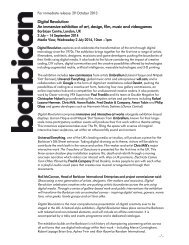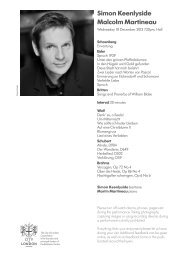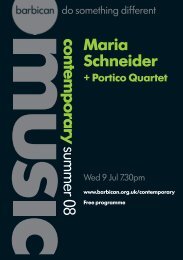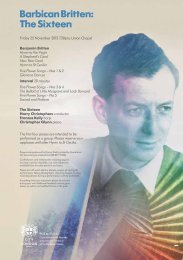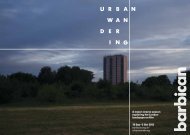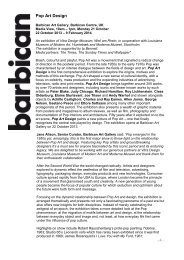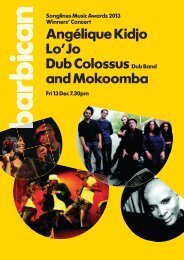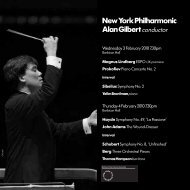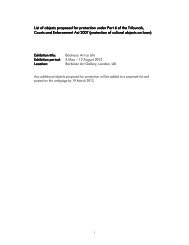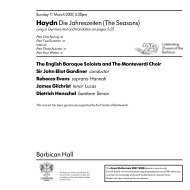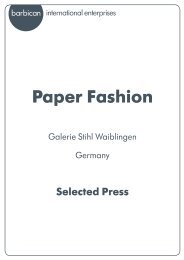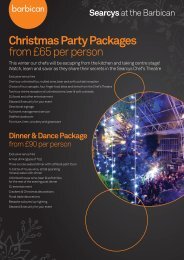Download your concert programme here - Barbican
Download your concert programme here - Barbican
Download your concert programme here - Barbican
You also want an ePaper? Increase the reach of your titles
YUMPU automatically turns print PDFs into web optimized ePapers that Google loves.
Vienna: the window to modernity<br />
Frequently, recitals cover whole<br />
centuries of musical history, the<br />
scale ranging from Mozart to<br />
late Romanticism. The singer not<br />
only wants to offer variety to his<br />
or her audience, but also wants<br />
to meet the challenge of coping<br />
with different musical ages,<br />
styles, authors and languages.<br />
In my current <strong>programme</strong> I<br />
concentrate on a comparatively<br />
short period: T<strong>here</strong> are only<br />
45 years between the Goethe<br />
Songs by Hugo Wolf and Erich<br />
Korngold’s ‘Das Eilende Bächlein’.<br />
But how very much happened in<br />
those few years between 1888 and<br />
1933, between the golden age of<br />
the German and Austro-Hungarian<br />
monarchies and the beginning<br />
of the Third Reich – not only in<br />
world history but also in the field of<br />
culture: Fin de siècle, Art nouveau<br />
and Expressionism, psychoanalysis<br />
and the women’s movement; the<br />
invention of the gramophone<br />
record, film, broadcasting;<br />
the boom of operetta and<br />
the cabaret; the Bauhaus and<br />
New Music movements.<br />
From a musical point of view, it<br />
was one of the richest and most<br />
exciting epochs in history, and<br />
one of the most important creative<br />
centres of those years was Vienna.<br />
It was in Vienna that many key<br />
developments and encounters<br />
took place – not to mention all<br />
the musical circles and salons,<br />
very often led by emancipated<br />
women, w<strong>here</strong> artists met<br />
and inspired one another.<br />
As a representation of the<br />
enormous artistic variety that<br />
originates from those years, today<br />
I would like to present to you<br />
works of five composers of that<br />
epoch whose tracks were closely<br />
linked. Hugo Wolf and Gustav<br />
Mahler, both born in 1860, joined<br />
the class of Robert Fuchs at the<br />
Vienna Academy of Music, but<br />
developed in highly different ways.<br />
Mahler supported the Wunderkind<br />
Erich Korngold and advised<br />
him to study with Alexander<br />
von Zemlinsky. Zemlinsky and<br />
Mahler, in turn, were connected<br />
through Alma Schindler. She had<br />
a roaring affair with Zemlinsky<br />
before marrying Mahler.<br />
Zemlinsky not only supported<br />
Korngold, but in a unique way<br />
also fostered Arnold Schoenberg.<br />
Later Zemlinsky’s sister Mathilde<br />
became Schoenberg’s wife. The<br />
influence of Mahler’s symphonic<br />
works on Schoenberg’s oeuvre<br />
and his 12-tone technique should<br />
not be underestimated. The<br />
deeper one immerses oneself<br />
in that musical epoch, the more<br />
fascinating it becomes.<br />
For me, working on these<br />
musical works was a wonderful<br />
personal journey, not least<br />
because I was shown what<br />
Vienna had been in those years:<br />
the window to modernity.<br />
Renée Fleming<br />
<strong>Barbican</strong> Classical Music Podcasts<br />
Prior to her recital at the <strong>Barbican</strong>,<br />
Renée Fleming talks exclusively to us,<br />
revealing the fascinating personal and<br />
musical links between the composers<br />
she will be performing.<br />
Subscribe to our podcast now for more exclusive interviews<br />
with some of the world’s greatest classical artists.<br />
Available on iTunes, Soundcloud and the <strong>Barbican</strong> website.<br />
2




